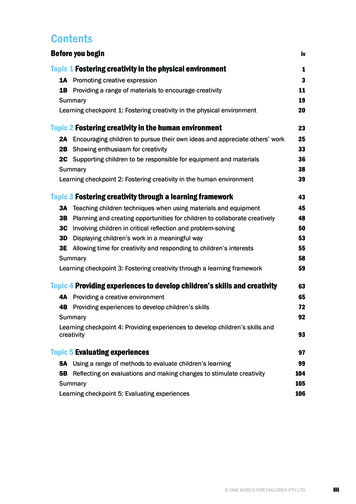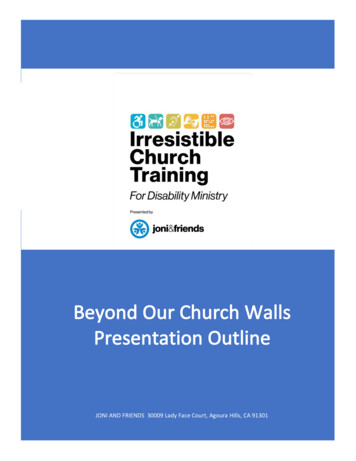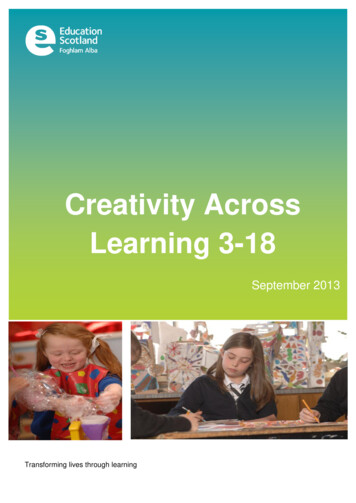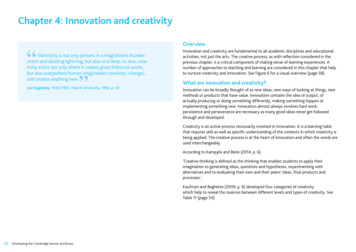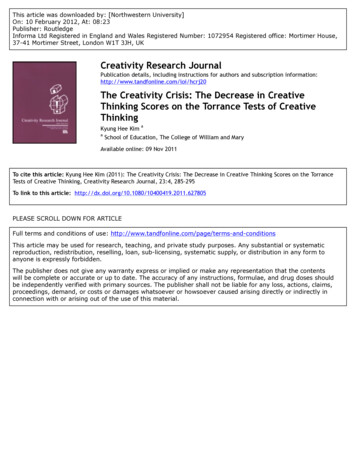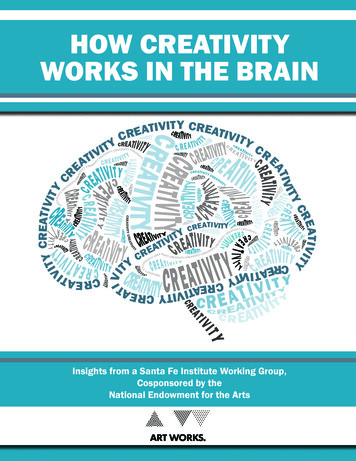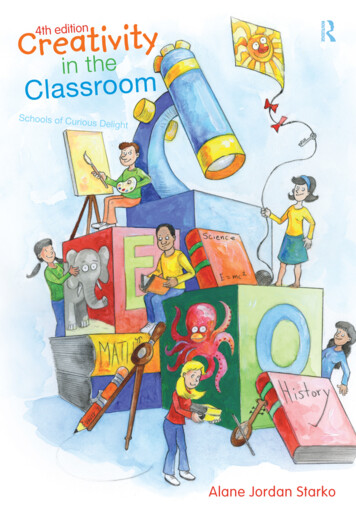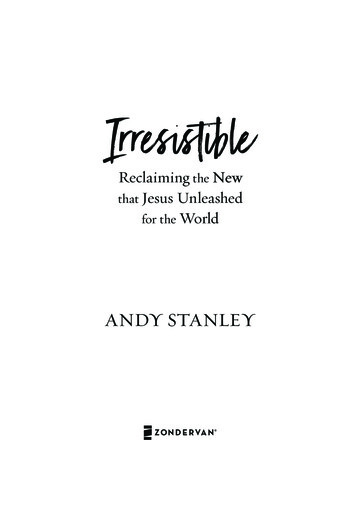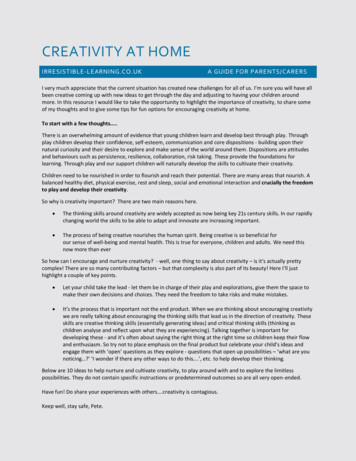
Transcription
CREATIVITY AT HOMEIRRESISTIBLE-LEARNING.CO.UKA GUIDE FOR PARENTS/CARERSI very much appreciate that the current situation has created new challenges for all of us. I’m sure you will have allbeen creative coming up with new ideas to get through the day and adjusting to having your children aroundmore. In this resource I would like to take the opportunity to highlight the importance of creativity, to share someof my thoughts and to give some tips for fun options for encouraging creativity at home.To start with a few thoughts .There is an overwhelming amount of evidence that young children learn and develop best through play. Throughplay children develop their confidence, self-esteem, communication and core dispositions - building upon theirnatural curiosity and their desire to explore and make sense of the world around them. Dispositions are attitudesand behaviours such as persistence, resilience, collaboration, risk taking. These provide the foundations forlearning. Through play and our support children will naturally develop the skills to cultivate their creativity.Children need to be nourished in order to flourish and reach their potential. There are many areas that nourish. Abalanced healthy diet, physical exercise, rest and sleep, social and emotional interaction and crucially the freedomto play and develop their creativity.So why is creativity important? There are two main reasons here. The thinking skills around creativity are widely accepted as now being key 21s century skills. In our rapidlychanging world the skills to be able to adapt and innovate are increasing important. The process of being creative nourishes the human spirit. Being creative is so beneficial forour sense of well-being and mental health. This is true for everyone, children and adults. We need thisnow more than everSo how can I encourage and nurture creativity? - well, one thing to say about creativity – is it’s actually prettycomplex! There are so many contributing factors – but that complexity is also part of its beauty! Here I’ll justhighlight a couple of key points. Let your child take the lead - let them be in charge of their play and explorations, give them the space tomake their own decisions and choices. They need the freedom to take risks and make mistakes. It’s the process that is important not the end product. When we are thinking about encouraging creativitywe are really talking about encouraging the thinking skills that lead us in the direction of creativity. Theseskills are creative thinking skills (essentially generating ideas) and critical thinking skills (thinking aschildren analyse and reflect upon what they are experiencing). Talking together is important fordeveloping these - and it’s often about saying the right thing at the right time so children keep their flowand enthusiasm. So try not to place emphasis on the final product but celebrate your child’s ideas andengage them with ‘open’ questions as they explore - questions that open up possibilities – ‘what are younoticing ?’ ‘I wonder if there any other ways to do this .’, etc. to help develop their thinking.Below are 10 ideas to help nurture and cultivate creativity, to play around with and to explore the limitlesspossibilities. They do not contain specific instructions or predetermined outcomes so are all very open-ended.Have fun! Do share your experiences with others .creativity is contagious.Keep well, stay safe, Pete.
CREATIVITY AT HOMEIRRESISTIBLE-LEARNING.CO.UK❶Shake things up!A great way to provoke creativity is to shake up the environment by introducing somethingfresh and interesting - that draws in children’s curiosity. We can move furniture around or setup things to create new play spaces indoors or outdoors. Once set up try and leave the optionsand possibilities open and follow your child’s lead. Examples could be pulling out the sofa tocreate a tunnel space behind, dens made with sheets or putting a tent up in the garden. Freshenvironments spark new ideas as children express themselves through play.THE TRUELY GREAT ADVANCES OF THIS GENERATION WILL BE MADE BY THOSE WHOCAN MAKE OUTRAGEOUS CONNECTIONS, AND ONLY A MIND WHICH KNOWS HOW TOPLAY CAN DO THAT (NAGLE JACKSON)2
CREATIVITY AT graphy is a wonderful way to engage young children. It works really well if you have anold digital camera. Show them how to use it and then let them explore. It’s great if you can thenmake time to look at their images together on a TV or laptop, giving them opportunity to talkabout their images and then this will stimulate further interest in taking more images. Itprovides a great insight into what interests them.Additional phy-capture-the-moment/THE IMPORTANT THING IS NOT TO STOP QUESTIONING3(EINSTEIN)
CREATIVITY AT HOMEIRRESISTIBLE-LEARNING.CO.UK❸PaperPaper is my all-time favorite material! It has endless possibilities. All my steel sculptures start with paperand card exploration! (see: petemoorhouse.co.uk) We can manipulate it in so many ways, crumple, fold,roll, tear, cut, slit, curl, hole punch, etc. We can join with tape, glue, staples, paperclips, rubber bands,string, split pins, clips, clothes pegs. So many types of paper: plain, coloured, newspaper, wallpaper,tracing paper, tissue paper etc. We can think about where paper comes from, think about recycling. Wecan mark-make on paper: draw, paint, charcoal, print etc. Children can make all sorts of things withpaper, watches, fans, envelopes etc and use it in different ways, weaving, folding, stencils, paper mache,collage, sculpture, emboss, prick holes . I particularly like combining a sheet of black paper with a sheetof white paper - as the contrast seems to draw in interest. Extension Activity: Cardboard (particularlygood with a low melt glue gun)4
CREATIVITY AT , charcoal, pencil, crayon, felt-tips, chalk, water . and made with brushes, sticks, rollers,hands, feet, etc Making marks with a variety of different media can be a great way for children to expressthemselves. Children will naturally investigate and experiment – exploring line, patterns,texture and shape. Children enjoy the sensory and physical experience of mark-making. It giveschildren the opportunity to express themselves and explore new beyond pen and paper. Markmaking can represent a child’s thoughts, ideas and feelings. I would suggest keeping markmaking fun and open ended rather than placing focus on trying to get children to make lettersand words. Notice and discuss what they are creating.WHEN NOTHING IS SURE, EVERYTHING IS POSSIBLE5(ATWOOD)
CREATIVITY AT HOMEIRRESISTIBLE-LEARNING.CO.UK❺Drawing ideas, drawing mapsGetting our ideas down on paper is a great way to be creative as children express their ideas.This can really incorporate anything. They could draw what they would like to do today, theycould draw what they would like to make from playdough, they could draw a map of the houseor garden, or how they used to get to school, they could draw their family, they could drawtheir ideas about questions they have such as how they think trees get turned into paper orwhy the rain falls from the sky, or how bees make honey putting pen to paper makeschildren’s thinking visible – and provides a wonderful way for us to observe and engage withtheir thinking skillsIMAGINATION IS THE BEGINNING OF CREATION6(SHAW)
CREATIVITY AT HOMEIRRESISTIBLE-LEARNING.CO.UK❻Mud, sand and waterMud is another great resource. Many settings have mud kitchens and it could be an option tocreate an area at home. Earth and water are two wonderful materials that capture children’sinterest, especially when then interact. Mixing soil, water and other materials such as leaves,grass, bits of bark etc. provide many options. A mud kitchen draws upon children’s love of therole play around cooking and their natural desire to be outdoors and connect with nature. Mudkitchens do not need a lot of resources, a couple of bowls or pans, a spoon or ladle, you couldmake the area together. A whole range of new recipes and concoctions will emerge! Of coursesand play and water play are also two timeless activities both being so open ended and full ofpossibilities Further uploads/2017/08/Making a mud kitchen english.pdfI HAVE NOT FAILED, I HAVE MERELY FOUND TEN THOUSAND WAYS THATWON’T WORK.(EDISON)7
CREATIVITY AT HOMEIRRESISTIBLE-LEARNING.CO.UK❼Loose partsLoose parts just refers to objects and materials that can be combined without beingpermanently joined. The great thing about loose part play is that the outcome is not predetermined - their explorations can become anything.So many things can become resources for loose parts – a bag of buttons, bottle tops, CDs,leaves etc A bonus is that all the materials can be reused time and time again. A great way torecord the results is for your child to take a photo of the work before it has to be cleared away.Loose part play develops children creative and critical thinking skills – do notice and talk aboutwhat they are creating.SUCCESS IN THE FUTURE FOR SOCIETY INCREASINGLY DEPENDS ON OUR ABILITY TOTHINK AND ACT CREATIVELY8
CREATIVITY AT HOMEIRRESISTIBLE-LEARNING.CO.UK❽Malleable materialsMalleable materials are materials that children can shape, push, pull, roll, squeeze, poke,scratch , pinch .Clay is wonderful, or make your own playdough - recipe below, other optionsinclude kitchen foil, wire, pipe cleaners, paper mache etc. We can also introduce tools withmalleable materials developing children’s coordination and agility. Tools such as a knife, garlicpress, rollers, cutting wheels etc. Let the children take the lead deciding how they would like toexplore or what they would like to create.Further nload/15457897/FT Clay Pamphlet.pdfTHINK LOW AND THINK HIGH, OH, THE THINKS YOU CAN THINK UP,IF ONLY YOU TRY(DR SEUSS)9
CREATIVITY AT HOMEIRRESISTIBLE-LEARNING.CO.UK❾NatureChildren need to get out and experience nature. So we need to make the most of when we cango out. Being in the fresh air, being physical, connecting with natural elements are so good forhealth and well-being. Nature also provides wonderful inspiration for our creative explorations.We can also be creative as we play outdoors, creating out own obstacle courses, playing withshadows, creating with loose parts outdoors, or sand, water and mud. Make some time tonotice and connect with nature, the clouds, bugs, new shoots. Children could take photographsof things they see – this focuses their attention, and further inspires other explorations.Further VITY IS CONTAGIOUS – PASS IT ON10(EINSTEIN)
CREATIVITY AT HOMEIRRESISTIBLE-LEARNING.CO.UK❿WoodworkWell you can’t get a resource from me with a mention of woodwork! I’m passionate about therich potential of woodwork. Children love woodwork. If you are fortunate to have a few toolsand offcuts of wood, woodwork can keep children engaged for quite some time. Children loveto combine other materials with wood such as beads, bottle tops, corks, fabric, string etc. Letthe magic unfurl. Woodwork works wonders.Further urces/#woodworkhttps://amzn.to/2R8CP80THROUGH WOODWORK CHILDREN LEARN THE SKILLS TO SHAPE THEIR WORLD11
SOME OTHER GREAT g with young ownload/16831488/FT Songs%2C Rhymes and Finger Plays wnload/15184829/FT Play fairydustteaching.com/Pete Moorhouse, Early years creative consultant and artist educatorwww.irresistible-learning.co.uk“EVERYONE HAS HUGE CREATIVE CAPACITIES. THE CHALLENGE IS TO DEVELOP THEM.”KEN ROBINSON12
IRRESISTIBLE-LEARNING.CO.UK A GUIDE FOR PARENTS/CARERS I very much appreciate that the current situation has created new challenges for all of us. Im sure you will have all been creative coming up with new ideas to get through the day and adjusting to having your children around more.

